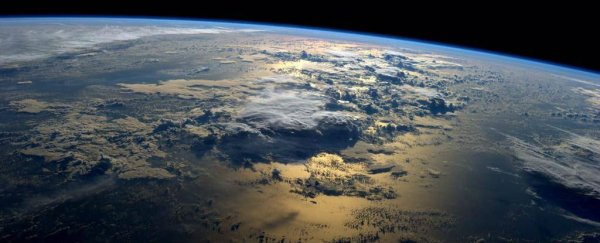Earth is such a habitable place, thanks in no small part to the vast magnetic field that surrounds our planet, shielding us from harsh solar winds and cosmic radiation.
But scientists have been investigating one of the most powerful geomagnetic storms in recent history, and they've discovered that our protective barrier isn't as secure as we thought it was. Turns out, our magnetosphere has been cracked.
Researchers have been analysing data from the GRAPES-3 muon telescope in Ooty, India, which recorded a massive burst of galactic cosmic rays on 22 June 2015.
For 2 hours, Earth's magnetosphere was being bombarded by these particles, which emit immensely high-energy radiation, and travel through space at nearly the speed of light.
These things are so powerful, they can easily penetrate the hull of a spacecraft, and Earth's magnetic shield is our first line of defence against them.
About 40 hours before the June 22 event, a giant cloud of plasma was ejected from the Sun's corona (or outer atmosphere), and eventually struck the magnetosphere at speeds of about 2.5 million kilometres per hour.
That's not exactly news, because at the time, it triggered a severe geomagnetic storm that was responsible for radio signal blackouts in many high latitude countries in North and South America.
It also resulted in a supercharged aurora borealis - which is created when charged particles from outer space reach Earth's atmosphere.
But now researchers have finally realised the full extent of that relentless bombardment of cosmic rays.
A team from the Tata Institute of Fundamental Research in India performed numerous simulations based on the GRAPES-3 data from that day, and the results indicate that the magnetosphere had been temporarily cracked, and that's why things went so haywire in our radio systems.
In fact, the team says the bombardment was so relentless, it caused a severe compression of the magnetosphere, forcing it to shrink from 11 to 4 times the radius of Earth.
The researchers suspect that the geomagnetic storm was powerful enough to actually 'reconfigure' our magnetic shield, prising open weak spots to let radiation and cosmic rays slip through.
"This vulnerability can occur when magnetised plasma from the Sun deforms Earth's magnetic field, stretching its shape at the poles and diminishing its ability to deflect charged particles," Katherine Wright explains on the American Physical Society website.
The fact that this happened at all is a concern, say the researchers, because it suggests that our magnetic field is changing - or rather, weakening - in certain parts.
"The occurrence of this burst also implies a 2-hour weakening of Earth's protective magnetic shield during this event," the researchers report.
"[This] indicates a transient weakening of Earth's magnetic shield, and may hold clues for a better understanding of future superstorms that could cripple modern technological infrastructure on Earth, and endanger the lives of the astronauts in space."
So the good news is our magnetosphere was only temporarily cracked, but the bad news is that it can be cracked at all.
There's not a whole lot we can do about that, but the researchers hope that by continuing to search for these cracks as they happen - and in past events - we'll be better prepared to deal with the next time those cosmic rays burst through and wreak havoc.
The research has been published in Physical Review Letters.
